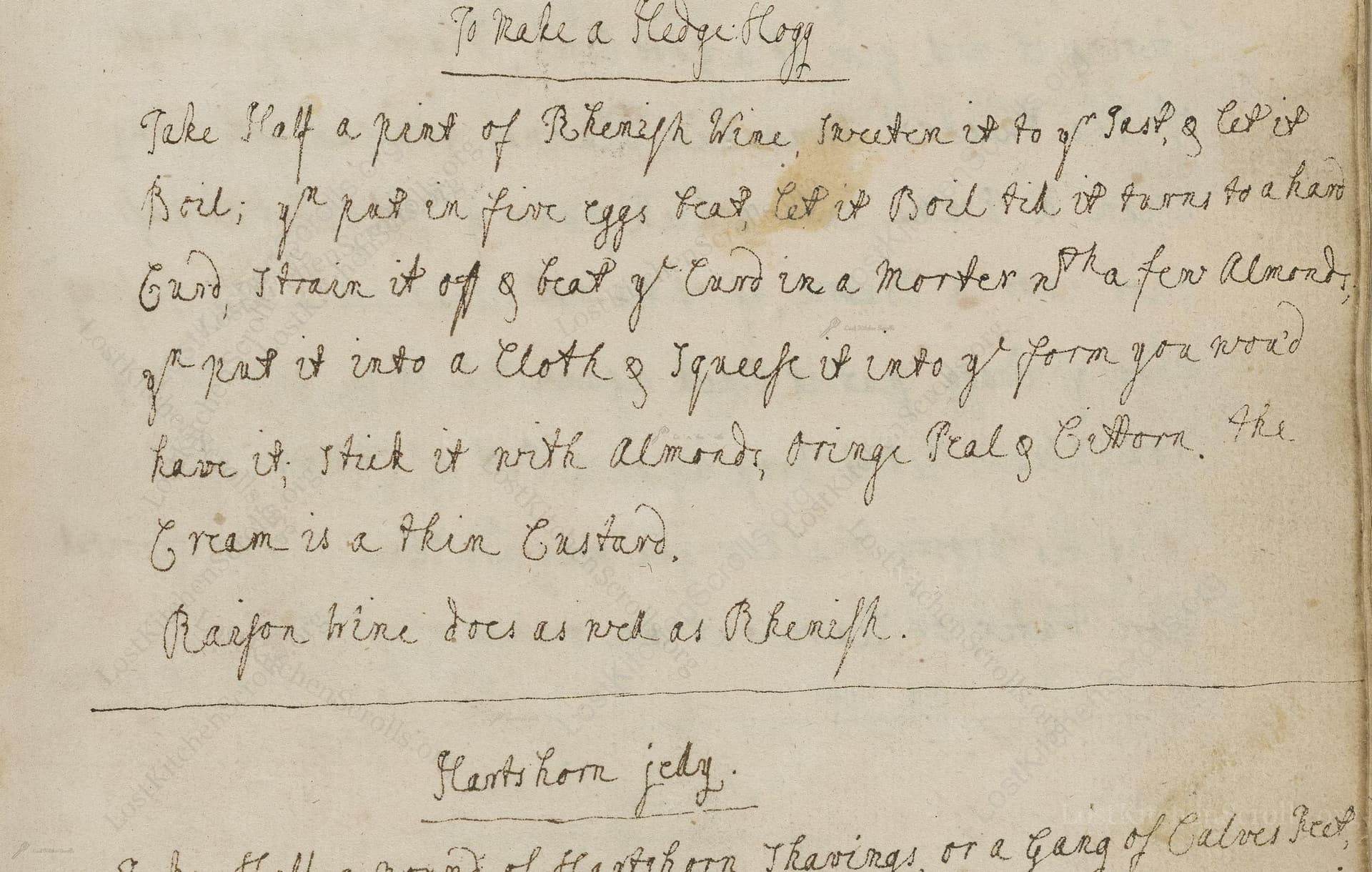To Make A Hedge Hogg
From the treasured pages of Receipt book of Elizabeth Smith
Written by Elizabeth Smith

To Make A Hedge Hogg
"Take Half a pint of Rhenish Wine, Sweeten it to yr Tast, & Let it Boil; yr put in five Eggs Beat yr Curd in a morter wth a few Almonds Grind, Strain it off & beat yr Curd very fine, & wth a little Orange Flower Water, or Risin water to ye Tast; yr put it into a Cloth & Squeeze it into ye form you would have it, Stick it with Almonds, Orange Peal & Cittern. The Cream is a thin Custard. Raisin Wine does as well as Rhenish."
Note on the Original Text
Like most 18th-century manuscripts, the recipe is brief, assumes background knowledge, and omits precise quantities and technical details ('yr' means 'your', and 'wth' means 'with'). The casual spelling reflects the lack of standardization for both ingredients and orthography of the time. Directions rely on the reader’s familiarity with techniques such as separating curds, scenting with flower water, and decorative presentation. The decorative element—creating a hedgehog from molded curd—would have been understood as a familiar party trick in fashionable kitchens.

Title
Receipt book of Elizabeth Smith (1775)
You can also click the book image above to peruse the original tome
Writer
Elizabeth Smith
Era
1775
Publisher
Unknown
Background
Step into the refined kitchens of the late 18th century with Elizabeth Smith, whose culinary wisdom offers a charming taste of Georgian elegance and time-honored recipes to delight any palate.
Kindly made available by
Folger Shakespeare Library
This whimsical dessert recipe comes from the creative domestic world of 18th-century England. Compiled by Elizabeth Smith between approximately 1749 and 1800, it showcases the playful side of Georgian cookery, where elaborate molds and presentations were all the rage at the dinner table. Dishes designed to mimic animals or fanciful shapes, such as 'hedgehogs', were a mark of refinement and hospitality. The recipe uses ingredients popular in upper-middle class and gentry households, such as imported wine, almonds, and delicately scented orange flower water, signaling both sophistication and international influences.

Historically, the recipe would have required a large mortar and pestle for beating the curds with almonds, and a sieve or cheesecloth for straining. Eggs would be hand-beaten, and wine gently heated over a hearth. For shaping, a clean linen cloth was pressed into service to help squeeze and mold the curd into the desired hedgehog form. To finish, slivers of nuts and preserved fruits were applied by hand as decoration. The thin custard would be cooked in a saucepan over gentle heat, stirred with a wooden spoon.
Prep Time
30 mins
Cook Time
10 mins
Servings
6
We've done our best to adapt this historical recipe for modern kitchens, but some details may still need refinement. We warmly welcome feedback from fellow cooks and culinary historians — your insights support the entire community!
Ingredients
- 10 fl oz Rhenish wine (substitute: dry Riesling or sweet sherry)
- 5 large eggs
- 2 tablespoons (1 oz) sugar, or to taste
- 1 1/2 oz blanched almonds
- 1/2 teaspoon orange flower water (optional: substitute with a few drops of vanilla or rosewater)
- Slivers of blanched almonds (decoration)
- Candied orange peel (for decoration)
- Candied citron (for decoration; optional)
- Thin custard or crème anglaise (for serving)
Instructions
- Start by heating 10 fluid ounces of Rhenish wine (or a fruity white wine or sweet sherry) in a saucepan.
- Add around 2 tablespoons (1 ounce) of sugar, or to taste, and let the mixture come to a gentle boil.
- In a mixing bowl, beat 5 large eggs thoroughly.
- Pour the hot wine over the eggs while whisking constanly.
- Then, pour this mixture into a large mortar (or use a food processor) and add 1 1/2 ounces of blanched almonds, grinding them together until a smooth, fine curd forms.
- Strain this mixture through a fine sieve or cheesecloth to seperate the curds.
- Take the strained curds and beat them well with a few drops (about 1/2 teaspoon) of orange flower water or, optionally, raisin water for aroma and flavor.
- Using a clean cloth, shape the curds by squeezing them into the rough form of a hedgehog.
- Decorate by inserting slivers of blanched almond (for the 'quills'), candied orange peel, and a few pieces of candied citron.
- Prepare a thin pouring custard (classic English custard, or a light crème anglaise) to serve as the 'cream' around your hedgehog when presenting.
Estimated Calories
320 per serving
Cooking Estimates
Preparing this dish takes some time because you need to carefully make the curds, form them into a hedgehog shape, and decorate with almonds and candied fruit. Cooking involves gently heating the wine and combining it with the eggs, then making a custard to serve with the finished dessert.
As noted above, we have made our best effort to translate and adapt this historical recipe for modern kitchens, taking into account ingredients nowadays, cooking techniques, measurements, and so on. However, historical recipes often contain assumptions that require interpretation.
We'd love for anyone to help improve these adaptations. Community contributions are highly welcome. If you have suggestions, corrections, or cooking tips based on your experience with this recipe, please share them below.
Join the Discussion
Rate This Recipe
Dietary Preference

Den Bockfisch In Einer Fleisch Suppen Zu Kochen
This recipe hails from a German manuscript cookbook compiled in 1696, a time whe...

Die Grieß Nudlen Zumachen
This recipe comes from a rather mysterious manuscript cookbook, penned anonymous...

Ein Boudain
This recipe comes from an anonymous German-language manuscript cookbook from 169...

Ein Gesaltzen Citroni
This recipe, dating from 1696, comes from an extensive anonymous German cookbook...
Browse our complete collection of time-honored recipes



